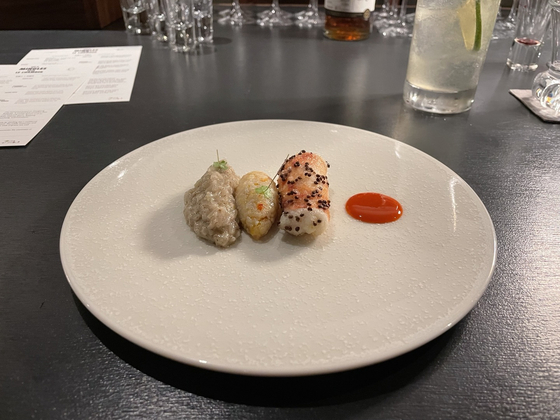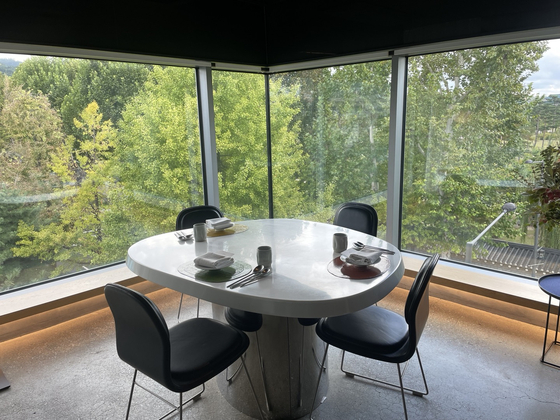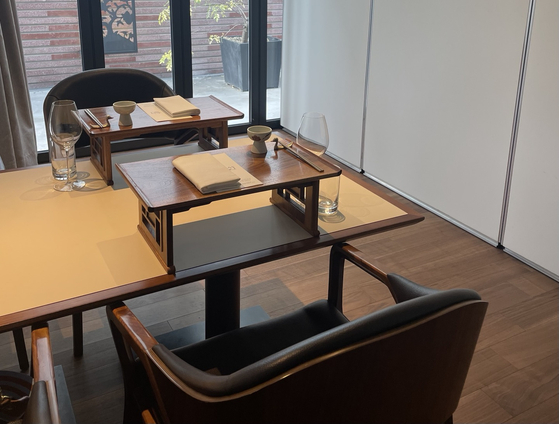[FOOD COURT] 'Tis the season to try something a little fancy
Published: 16 Nov. 2022, 16:16
Updated: 03 Mar. 2023, 18:07
![A chicken skewer at Mingles, where diners can see how every-day Korean food can adapt to make dishes fit for fine dining restaurants [LEE SUN-MIN]](https://koreajoongangdaily.joins.com/data/photo/2023/03/03/33d4c0ae-0951-4713-bc31-c897f92662d5.jpg)
A chicken skewer at Mingles, where diners can see how every-day Korean food can adapt to make dishes fit for fine dining restaurants [LEE SUN-MIN]
The festive season is just around the corner and for many people that means one thing: A chance to eat, drink and be merry with friends.
Finding the best place to visit for a holiday mean isn't easy, especially if you want everything to be just right so you can enjoy the day with family and friends. To help you find what you are looking for, here are some of the best fine dining spots that could help make your meal extra special.
Fine dining restaurants might not be the sort of place you frequent regularly, but diners in Korea often choose to try something a little fanciers for occasions like birthdays, Valentine’s Day and Christmas. To give fine dining a Korean edge, it's best to visit restaurants that offer food with a distinctly Korean twist. That way, you can see how much potential everyday Korean food has.
![Vegetable tart at Mosu [LEE SUN-MIN]](https://koreajoongangdaily.joins.com/data/photo/2023/03/03/58b2c3ab-233d-4273-ad9d-85d5f27c54f6.jpg)
Vegetable tart at Mosu [LEE SUN-MIN]
Many of these restaurants enjoy international acclaim, so if you have some serious foodie friends to impress, these are the places to aim for.
Getting a seat at some of these restaurants is very competitive, especially toward the end of the year. If any of the options seem appealing to you, get booking immediately. Even if the seats are all taken, make sure to ask whether you can go on the waitlist. If you are lucky, you might be able to get a seat after all.
Mosu
Without a doubt, many foodies and chefs agree that Mosu, at the moment, is a restaurant where demand far outpaces the number of available seats. It got even more competitive after the restaurant was awarded three stars by the Michelin Guide Seoul in October.
It is one of those rare restaurants in Seoul that occupies an entire building. The dining area is spread over two stories, with a view of the open kitchen on the first floor and a little more privacy on the second floor.
The noodle dish here is one of the most popular items on the menu. It offers a plate of wheat noodles with a sauce and garnish that changes seasonally — sometimes with berries, other times with truffles and more. Another specialty is its tart, made with commonly used Korean ingredients like ueong (root vegetables) or myeolchi (anchovies).

![Food and wine served at Mosu [LEE SUN-MIN]](https://koreajoongangdaily.joins.com/data/photo/2023/03/03/d4a97056-408a-4fb0-8d03-b30f0b936df9.jpg)
Food and wine served at Mosu [LEE SUN-MIN]
The restaurant isn’t just known for its food, it has also been recognized for its wine service as well. Breaking the prejudice that Korean food uses too much spice to pair with wine, the restaurant offers a chance for you to think outside the box and find the perfect wine to pair with your fish served with gochujang (hot pepper paste) sauce.
@mosuseoul
45 Itaewon-ro 55-ga-gil, Yongsan District
Mingles
Mingles is one of the first restaurants to try out the genre known as modern or contemporary Korean in Seoul. It established its identity as a modern Korean restaurant by some of the signature dishes such as Jang Trio, a dessert made with three types of fermented Korean sauces including doenjang (fermented soybean paste), gochujang (fermented hot pepper paste) and ganjang (soy sauce). Jang Trio is one of the first dishes Mingles has served since it opened in 2014.

![Lobster and rice together with gochujang sauce, top, at Mingles, and the restaurant's signature Jang Trio dessert, above [LEE SUN-MIN]](https://koreajoongangdaily.joins.com/data/photo/2023/03/03/f524ccc2-d589-4df7-8919-af205291e6c0.jpg)
Lobster and rice together with gochujang sauce, top, at Mingles, and the restaurant's signature Jang Trio dessert, above [LEE SUN-MIN]
It is also the place to try out trendy Korean liquors. The restaurant offers a number of traditional Korean style drinks paired with its dishes, so you can grab a chance to see what drinks are currently made in Korea. Some of the drinks are available at local retailers if you are looking to gift friends and family back home.
@mingles_restaurant
19 Dosandae-ro 67-gil, Gangnam District
Onjium
While the first two are more focused on introducing Korean flavors using techniques that are more global, the latter two focus more on using Korean techniques to cook the ingredients. The restaurant has its team study old recipe books from centuries ago to find a way to reinvent old Korean dishes for the modern era.
Although not exactly the same from the recipe books, the chefs here use their creativity to bring ancient dishes to life. Many locals also find some of the Korean dishes served here very innovative.

![The view of Gyeongbok Palace out the window of Onjium, top, and one style of kimchi served at the restaurant [LEE SUN-MIN]](https://koreajoongangdaily.joins.com/data/photo/2023/03/03/1f4bf2d1-a123-4477-9aed-3365886c7e43.jpg)
The view of Gyeongbok Palace out the window of Onjium, top, and one style of kimchi served at the restaurant [LEE SUN-MIN]
Located steps away from Gyeongbok Palace, the restaurant offers a view of the palace from afar. It is possible to see the fall foliage over the walls of the traditional Korean homes in fall, and snow on the roof in winter.
The other floors of the building where the restaurant is located show off Korean heritage, ranging from clothing to housing, so it is a good place to get a broad glimpse of Korean culture cultivated over the years.
@onjium_restaurant
49 Hyoja-ro, Jongno District
Kwon Sook Soo
This is one of the few restaurants that uses Korean sauces made from scratch. Given that many of the Korean sauces, called jang, need at least a year to be properly fermented and to have a deep flavor, using house-made jang or sauce is extremely difficult and rare at most modern Korean restaurants — but Kwon Sook Soo does it all.

![Soban, or traditional Korean tables, used to serve food on top of the dining table at Kwon Sook Soo [LEE SUN-MIN]](https://koreajoongangdaily.joins.com/data/photo/2023/03/03/644cd71f-7ad5-4347-b904-040e0f6c28c0.jpg)
Soban, or traditional Korean tables, used to serve food on top of the dining table at Kwon Sook Soo [LEE SUN-MIN]
One of the key differences one can find at Kwon Sook Soo is how they serve their food. The restaurant uses a miniature soban, a traditional Korean table, on top of the Western-style dining table to serve the food. Soban were used often in the Joseon Dynasty (1392-1910) as an individual dining table or for studying. To make the soban work as a tabletop setting, the restaurant has specially made unusually low tables.
@kwonsooksoo
37 Apgujeong-ro 80-gil, Gangnam District
BY LEE SUN-MIN [lee.sunmin@joongang.co.kr]










with the Korea JoongAng Daily
To write comments, please log in to one of the accounts.
Standards Board Policy (0/250자)